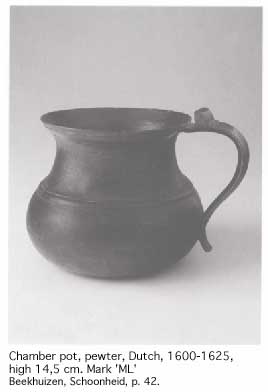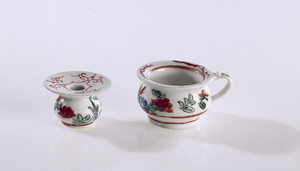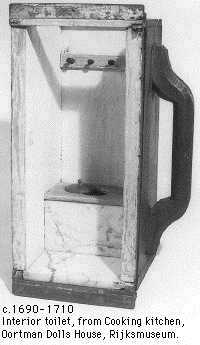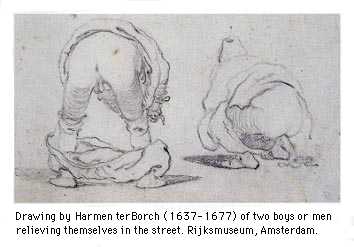 Chamber
pot, urinal, potty, pisspot
Chamber
pot, urinal, potty, pisspot Chamber
pot, urinal, potty, pisspot
Chamber
pot, urinal, potty, pisspot
Four tin chamber pots 'tinne waterpotten', either empty or full stood in the yard of the Thins/Vermeer home.
They were also put inside commode stools.
For emptying these piss pots see trash.
Go to the full Menu of art history tours.
 The
image below show both a water pot (piss pot) and a spittoon.
The
image below show both a water pot (piss pot) and a spittoon.
If there was a toilet within the house, it could have been placed at the yard, reachable either from within or via the open air. Alternatively the toilet could have been placed in the inner kitchen, such as in the van Oortman Dolls House (Rijksmuseum, Amsterdam) or within another room.
Finally there is the option that chamber pots were the only method for relieving. Chamber pots were emptied in so calles waste straw barges, 'stroschuiten' which went on regular times through the canals. See also the commode stool, a box shaped secreet koffer (Pijzel, Pronkpoppenhuis, 2000, p. 178.).
 Note
: This object was part of the Vermeer-inventory as listed by the
clerk working for Delft notary public J. van Veen. He made this list
on February 29, 1676, in the Thins/Vermeer home located on Oude
Langendijk on the corner of Molenpoort. The painter Johannes Vermeer
had died there at the end of December 1675. His widow Catherina and
their eleven children still lived there with her mother Maria
Thins.
Note
: This object was part of the Vermeer-inventory as listed by the
clerk working for Delft notary public J. van Veen. He made this list
on February 29, 1676, in the Thins/Vermeer home located on Oude
Langendijk on the corner of Molenpoort. The painter Johannes Vermeer
had died there at the end of December 1675. His widow Catherina and
their eleven children still lived there with her mother Maria
Thins.
The transcription of the 1676 inventory, now in the Delft archives, is based upon its first full publication by A.J.J.M. van Peer, "Drie collecties..." in Oud Holland 1957, pp. 98-103. My additions and explanations are added within square brackets [__]. Dutch terms have been checked against the world's largest language dictionary, the Dictionary of the Dutch Language (Woordenboek der Nederlandsche Taal , or WNT), which was begun by De Vries en Te Winkel in 1882. In 2001 many textile terms have been kindly explained by art historian Marieke te Winkel.
Last two illustrations taken from the recently published handbook on Dutch Doll Houses by Jet Pijzel-Dommisse,Het Hollandse pronkpoppenhuis, Interieur en huishouden in de 17de en 18de eeuw, Waanders, Zwolle; Rijksmuseum, Amsterdam, 2000, ill. 308, 309.
Lit.: L.F.H.H. Beekhuizen, De schoonheid van het oude tin. Een overzicht van vijf eeuwen tin, Pilkington & Larousse, 's-Hertogenbosch 1998.
This page forms part of a large encyclopedic site on Vermeer and Delft. Research by Drs. Kees Kaldenbach (email). A full presentation is on view at johannesvermeer.info.
Launched December, 2002; Last update March 2, 2017.
Back to the Welcome page: click Welcome.
 Relieving
oneself in public view on the public road was not uncommon; it was
not yet felt as shameful in broad circles. The gradual increase of
the feeling of private shame concerning relieving oneself in the open
air is described by Elias in Civilisation Process
Relieving
oneself in public view on the public road was not uncommon; it was
not yet felt as shameful in broad circles. The gradual increase of
the feeling of private shame concerning relieving oneself in the open
air is described by Elias in Civilisation Process